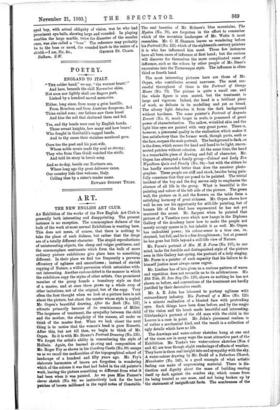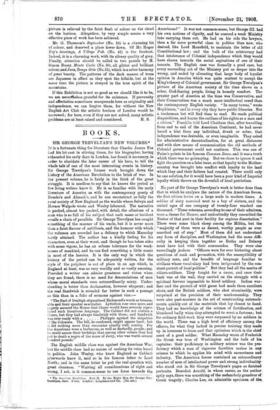ART.
THE NEW ENGLISH ART CLUB.
AN Exhibition of the works of the New English Art Club is generally both interesting and disappointing. The present instance is no exception. The commonplace dulness of the bulk of the work at more normal Exhibitions is wanting here. This does not mean, of course, that there is nothing to take the place of such dulness, but rather that the dregs are of a totally different character. The stupid reproductions of uninteresting objects, the cheap and vulgar prettiness, and the commonplace sentiments which form the bulk of more ordinary picture exhibitions give place here to something different. In their place we find too frequently a perverse effrontery of ugliness and uncouthness ; instead of slavish copying of Nature, a wilful perversion which astonishes with- out interesting. Another curious defect is the manner in which the exhibitors copy the styles of other artists. One prominent member of the group founds a transitory style on that of a master, and at once there grows up a whole crop of other imitations, not of the original, but of the copy. Very often the first thought when we look at a picture here is not about the picture, but about the master whose style is copied. Mr. Orpen's beautiful drawing, After the Bath (No. 137), attracts primarily because of its reminiscence of Millet. The largeness of treatment, the sympathy between the child and the mother, the simplicity of the masses, all make us think of the master first. When we look closer the next thing is to notice that the woman's head is pure Rossetti. After this, but not till then, we begin to think of Mr. Orpen. So it is with Mr. Strang's Portrait Drawing (No.135). We forget the artist's ability in remembering the style of Holbein. Again, the learned dr Lwing and composition of Mr. Roger Fry as shown in his Coudray Castle (No. 98) escape us as we recall the mediocrities of the topographical school of landscape of a hundred and fifty years ago. Mr. Fry's elaborate harmonies of brown are forgotten in wondering which of the colours it was that had faded in the old painter's work, leaving the picture something so different from what it had been when it was painted. As we pass Miss Fanner's clever sketch (No. 84) we instinctively look for the bare patches of brown millboard in the rapid notes of Constable.
The real beauties of Mr. Holmes's blue mountains, The Mysten (No. 78), are forgotten in the effort to remember which of the mountain landscapes of Mr. Watts it most resembles. Mr. C. H. Shannon leaves us wondering before his Portrait (No. 121) which of the eighteenth-century painters it is who has influenced him most. These few instances have all been cases of influence at first hand; but the curious will discover for themselves the more complicated cases of influence, such as the echoes by other people of Mr. Steer's excursions into the Tunaeresque style. The influence is often third or fourth hand.
The most interesting pictures here are those of Mr. Orpen, who contributes several canvases. The most suc- cessful throughout of these is the Portrait of George Moore (No. 73). The picture is quite a small one, and the whole figure is seen seated, but the treatment is large and vigorous. Indeed, the head is a brilliant piece of work, so delicate in its modelling and yet so broad.
The silvery light detaches it from the dark background without hardness. The same painter's Portrait of Augusta Everett (No. 9), much larger in scale, is possessed of great power of characterisation. The sallow, wrinkled skin and the light blue eyes are painted with very great power. There is, however, a piecemeal quality in the realisation which makes it less satisfactory than the former work, though parts, such as the face, surpass the male portrait. The background is dark, as is the dress, which causes the head and hand to be light, uncon- nected patches without cohesion. At the same time, the hand is a remarkable piece of drawing and full of character. Mr. Orpen has attempted a family group—Colonel and Lady Eva Wyndham Quin and Family (No. 94)—but with the sitters he has hardly succeeded better than does the amateur photo- grapher. These people are stiff and stark, besides being pain- fully conscious that they are posed to be painted. The trivial incident of the boy and the dog serves only to emphasise the absence of all life in the group. What is beautiful is the painting and colour of the left side of the picture. The green wall, the picture on it, and the flowers on the table form a satisfying harmony of great richness. Mr. Orpen shows how well he can use his opportunity for still-life painting, but of human life of the kind here represented he has not yet mastered the secret. Mr. Sargent when he painted that picture of a Venetian room which now hangs in the Diploma Gallery of the Academy knew how to make the people not merely occupy spaces in it, but inhabit it as well. Mr. Orpen has undoubted power; his colour-sense is a true one, re. strained, but full, and he is a fine draughtsman ; but at present he has gone but little beyond a still-life view of Nature.
Mr. Furse's portrait of Mrs. M. B. Furs. (No. 107), to our mind, lacks the forcible and distinguished style of the picture seen in this Gallery last spring, the portrait of a lady singing. Mr. Furse is a painter of such capacity that his failure to do himself justice must always cause regret.
Mr. Lindner has of late given us a curious pattern of wares and repetition does not reconcile us to its arbitrariness. His Ebb Tide, St. Ives Bay (No. 120), shows us nothing he has not shown us before, and conventions of the treatment are hardly justified by their decorative result.
Mr. A. E. John has laboured to portray ugliness with extraordinary industry. His Portrait of a Man (No. 125)
is a minute realisation of a bloated face with protruding eyes. Such things have been done before, and by the magic of the vision and the brush made beautiful and interesting.
Ghirlandajo's portrait of the old man with the child in the Louvre is a case in point. Mr. John's piecemeal realism is of rather a mechanical kind, and the result is a collection of ugly details which have no life.
The drawings and water-colour sketches hung at one end of the room are in many ways the most attractive part of the Exhibition. Mr. Tonks's two water-colour sketches (Nos. 6 and 41) are true though slight renderings of effects of weather, They have in them real insight into and sympathy with the sky. A water-colour drawing by Mr. Dodd of a Suburban Church, Manchester (No. 142), is a good example of what artistic feeling can make of unpromising material. There is dis- tinction and dignity about the mass of building rearing
itself up dark against the sombre sky, which comes from its being treated as one mass, and not being broken up by the statement of insignificant facts. The sombreness of the
• pictnre is relieved by the faint flush of colour on the cloud on the horizon. .Altogether, by very simple means a very • effective piece of work has been achieved.
• Mr. G. Thomson's September (No. 16) is a charming bit of colour, and deserved a place lower down. Of Mr. Roger Fry's drawings, A Village Pa. (No. 42) is the freshest. Indeed, it is a charming work, with its silvery quality of grey. Finally, attention should be called to two pastels by M. Simon Hussy, Monte Carlo (No. 50), all glitter and brilliant colour, and Tura, Temps Gris (No. 51), which is a sober harmony of great beauty. The patterns of the dark masses of trees are Japanese in effect as they spot the hillside, but at the same time the picture is steeped in the true spirit of the mountains.
If this Exhibition is not so good as we should like it to be, we are nevertheless grateful for its existence. If perversity and affectation sometimes masquerade here as originality and independence, we can forgive them, for without the New English Art Club the artistic horizon of London would be narrowed; for here, even if they are not solved, many artistic problems are at least raised and considered. H. S.



























































 Previous page
Previous page